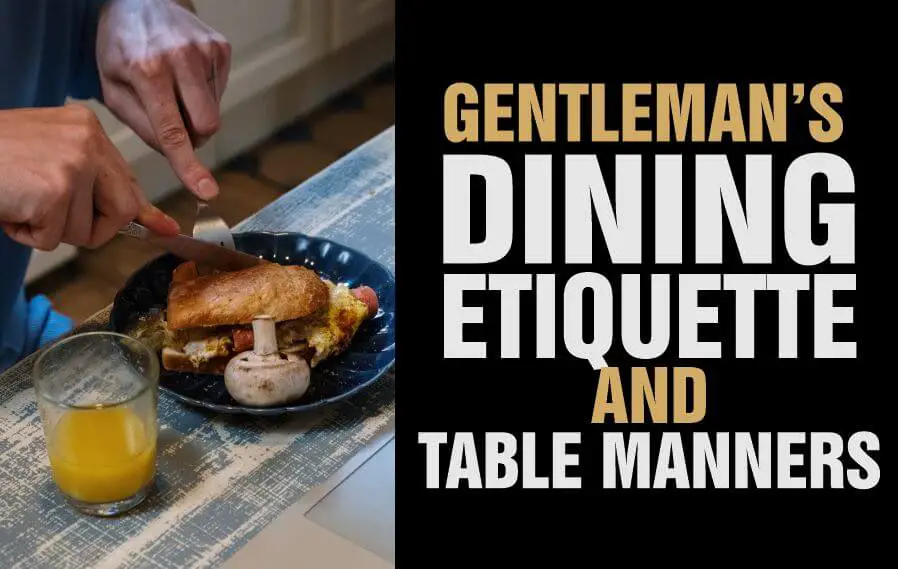Last updated on January 25th, 2025 at 02:08 am
The art of dining will ever remain and so will dining etiquette and table manners including the art of making a toast, especially for the gentleman.
I was always shy and apprehensive when served food in public places, especially on occasions. I mostly politely rejected foods in these places because I lacked composure and might embarrass myself and maybe others.
But I learned the rules because, these occasions were inevitable.
A gentleman’s poise and grace at the table reflect his respect for others and his appreciation of shared experiences.
Whether it’s a business dinner or a romantic date, a gentleman’s polished dining etiquette exudes sophistication and respect for others.
From dressing appropriately to using utensils with finesse, we’ll explore the essential practices that elevate the image of the gentleman and create a positive impression in any dining setting.
You might want to read the general gentleman etiquette.
You might want to pin the image below.
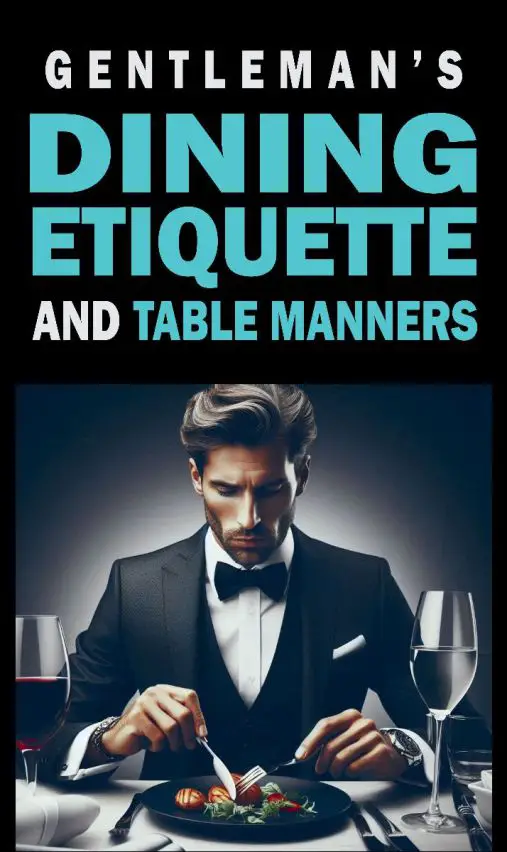
Table of Contents
- How Good Table Manners Reflect a Gentleman’s Refinement and Respect
- Seating and Napkin Guidelines
- Proper Use of Cutlery: Forks, Knives, and Spoons
- The Continental vs. American Eating Styles
- Resting Positions for Utensils During the Meal
- Handling Difficult Food Items and Special Etiquette Situations
- Handling Unwanted Foods Discreetly
- Managing Dietary Restrictions or Allergies Without Causing a Fuss
- Proper Use of Glassware
How Good Table Manners Reflect a Gentleman’s Refinement and Respect

Good table manners are a reflection of a gentleman’s refinement and respect because they demonstrate your ability to conduct yourself with grace, poise, and consideration for others in a formal setting.
The way a person behaves at the table is a direct reflection of their character and upbringing, and it speaks volumes about their level of refinement and social skills.
Having good table manners shows that a gentleman has been taught and has learned to respect the dining experience and the people around him.
This includes using proper utensils, chewing with closed mouths, not talking with food in the mouth, and using polite language and gestures.
Seating and Napkin Guidelines
Dining etiquette for the gentleman requires that he observes every detail and act according in the dining area.
Here are tips…
1. Understanding proper seating etiquette at the table: Proper seating etiquette for gentlemen typically involves waiting for the host to indicate where to sit.
If there is no host, men generally allow women to be seated first and then choose their seats accordingly.
It is considered polite to assist women in pulling out their chairs and pushing them back in when they are seated.
2. Unfolding and using the napkin appropriately: When seated, a gentleman should wait for the host or the highest-ranking person at the table to unfold their napkin first.
Following suit, he should unfold his napkin and place it on his lap, with the fold facing towards his midsection.
The napkin should be used to dab the mouth and hands during the meal, and it should be used discreetly without making any noise or drawing attention.
Proper Use of Cutlery: Forks, Knives, and Spoons

Using utensils with grace by the gentleman refers to the proper manners and etiquette associated with using cutlery, such as forks, knives, and spoons, during a meal.
This entails following certain guidelines and techniques to display elegance and refinement while eating.
Here are tips…
Forks: When using a fork, it is important to hold it in the dominant hand with the prongs facing downwards.
The fork should be used to spear or scoop food, and should never be used to shovel or stab aggressively.
Knives: Knives should be held in the dominant hand with the blade facing inward. They are primarily used for cutting food into manageable sizes, but should not be used for lifting food to the mouth.
Related: Wine Basics and Etiquette
Spoons: When using a spoon, it should be held in the dominant hand and used for scooping and sipping liquids or soft foods.
Bringing the spoon up to the mouth is essential, rather than lowering the face to the spoon.
The Continental vs. American Eating Styles
Continental Eating Style
In the continental eating style also known as the European or ‘zigzag’ style, this method of eating involves holding the fork in the left hand and the knife in the right hand throughout the entire meal.
Food is usually cut using a knife, and then the fork is used to lift it to the mouth.
This style allows for a smoother, continuous flow of eating.
American Eating Style
In the American eating style, the fork is initially held in the right hand to spear and cut food, then switched to the left hand to lift it to the mouth.
The knife is usually put down after cutting and then used again when needed.
American style tends to be more relaxed and is often used in informal settings.
Resting Positions for Utensils During the Meal
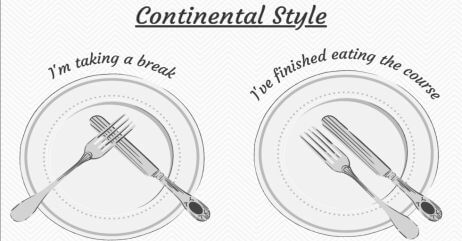
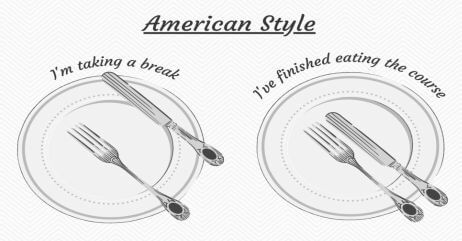
Resting Fork: When taking a break from eating or pausing during a course, a gentleman should place the fork with the tines facing upwards on the edge of the plate.
This indicates that the meal is not finished and the course is not complete.
Resting Knife: Similarly, the knife should be placed on the right side of the plate, diagonally with the sharp edge facing inwards.
This signals that it is not in use, but still signifies that the diner intends to continue with the course.
Resting Spoon: If a spoon is being used during the meal, it can be placed diagonally across the top of the plate, with the handle pointing to the right and the bowl of the spoon facing upwards.
Following these manners and properly navigating the use of cutlery, understanding different eating styles, and utilizing appropriate resting positions for utensils during a meal contribute to a refined and sophisticated dining experience for the gentleman.
Recommended: How to Make First Impressions Like a Gentleman
Handling Difficult Food Items and Special Etiquette Situations
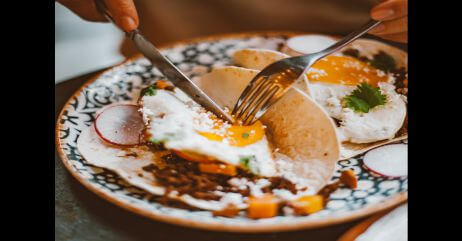
A true gentleman exhibits poise and tact when faced with tricky foods and challenging dining situations.
By navigating these scenarios with grace and consideration, he ensures a seamless dining experience for himself and those around him.
Here are some tips…
Certain foods or etiquette situations can present challenges even to the most seasoned gentleman. Here are a few tips on handling them with finesse:
1. Shellfish and seafood: When dealing with shellfish, use the appropriate utensils, such as oyster forks or lobster picks, to extract the meat without making a mess. If a particular seafood item is unfamiliar, observe others at the table or ask discreetly for guidance.
2. Spaghetti and long pasta: Twirl a small amount of spaghetti onto your fork by using the side of the bowl, or employing the help of a spoon as a base. Avoid slurping or cutting it into smaller pieces.
3. Handling bones and pits: When faced with bones from fish or meat, discreetly remove them from your mouth using your fork or spoon. Place pits or seeds from fruits in your spoon or on the side of your plate, rather than spitting them out.
4. Special dietary restrictions: If you have dietary restrictions or allergies, it is advisable to inform your host or restaurant in advance. This allows them to make the necessary accommodations, ensuring you have a pleasant dining experience without causing any inconvenience.
Remember, the key to handling difficult food items or special etiquette situations lies in discretion, confidence, and observing others to ensure that you are following the expected norms.
By adhering to these guidelines, you will demonstrate your polished dining etiquette and ensure an enjoyable experience for yourself and those around you.
Handling Unwanted Foods Discreetly
A gentleman politely manages unwanted foods without drawing attention or causing discomfort.
If served something you do not prefer or cannot eat, discreetly leave the food untouched on the plate.
You should refrain from making negative comments or pushing the food around the plate.
By handling the situation with subtlety and grace, you avoid drawing unnecessary attention to your preferences.
Managing Dietary Restrictions or Allergies Without Causing a Fuss
In the case of dietary restrictions or allergies, a true gentleman addresses them politely but without making a fuss.
You should communicate your needs with the host or server discreetly and appreciatively.
Instead of making your restrictions the focus of the meal, you should gracefully navigate the menu to find suitable options.
By doing so, you ensure a harmonious dining experience for yourself and your fellow diners.
Related: How to Send and Respond to RSVP
Proper Use of Glassware

A gentleman exhibits sophistication and savoir-faire in the proper use of glassware during dining and social gatherings. Mastering the art of glassware usage enhances the overall dining experience and reflects your refined manners.
Here are some tips…
Identifying and Using Various Types of Glassware
A true gentleman familiarizes himself with different types of glassware, such as wine glasses, water glasses, and cocktail glasses. You should use the appropriate glass for each beverage, showcasing your knowledge of proper table settings and etiquette.
Appropriate Handling and Toasting Etiquette
When handling glassware, a gentleman holds the stem of the glass to avoid leaving fingerprints on the bowl, maintaining a pristine appearance. During toasts, he raises his glass gracefully, making eye contact, and avoids clinking glasses too forcefully to prevent spillage or breakage.
Keeping Track of One’s Own Glass to Avoid Confusion
To avoid confusion, a gentleman takes responsibility for keeping track of his glass.
You have to avoid accidentally picking up someone else’s glass by being mindful of its placement and using subtle identifiers, like a small charm or unique positioning, to distinguish your glass from others.
Paying the Bill and Departing
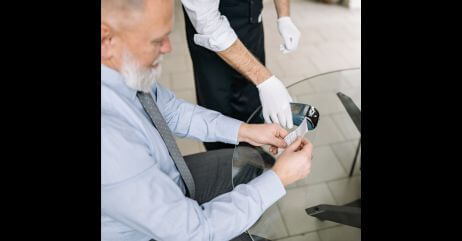
After dining, it is in good taste to handle the bill and departure with courtesy and consideration, leaving a positive impression on your fellow diners.
Here are some things to consider…
Offering to Pay the Bill or Share Expenses, if Appropriate:
A true gentleman offers to pay the bill as a gesture of hospitality, especially if he invited others. However, if the gathering is more casual or if others insist on sharing expenses, he gracefully accepts their contribution.
You should avoid any awkwardness surrounding the bill by handling it discreetly and without drawing attention.
The Appropriate Way to Thank the Host and Express Gratitude
When dining as a guest, you should express sincere gratitude to the host for the invitation and the enjoyable meal. A simple, heartfelt thank-you suffices, showing appreciation for the host’s hospitality and efforts.
Leaving the Table and Saying Goodbye Politely
As the meal concludes, take your cue from the host or the group to signal the end of the gathering. You should rise from the table gracefully, thanking the host once more, and says goodbye to others politely. If there are specific rituals for departure, he follows them respectfully.
Modern Dining Etiquette in Casual Settings for the Gentleman
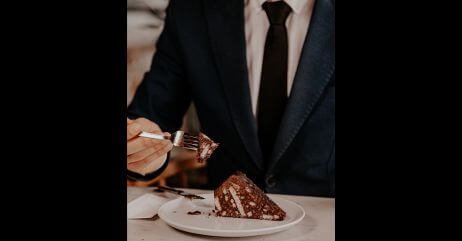
In today’s more relaxed and informal dining settings, a gentleman can still showcase his refined manners while adapting to the casual atmosphere.
By applying principles of respect and consideration, you elevate the dining experience for everyone involved.
Here are how he achieves that…
Adapting Dining Etiquette to Casual and Social Dining Scenarios
In casual settings, you can adjust your approach while still maintaining basic dining etiquette and table manners.
You may use a more relaxed grip on utensils as you remain mindful of the conversation flow, engaging in light-hearted topics suitable for the occasion.
While some rules may be less strict, you can continue to practice proper table manners and avoid any behaviors that may be perceived as impolite.
Related: How to Give Gifts Like a Gentleman
Applying Principles of Respect and Consideration in Any Dining Situation
Irrespective of the setting, a true gentleman always demonstrates respect and consideration towards others.
So, it is in good taste you refrain from interrupting, listen actively, and refrain from using phones excessively during meals.
Being attentive to the needs of others and preferences, you adapt to the dining style of the group while still adhering to essential etiquette guidelines.
How Proper Table Manners Contribute to a Gentleman’s Overall Image
Proper table manners are an extension of a gentleman’s overall image.
Displaying respect and consideration in casual dining scenarios shows that you value and respect the people you share meals with.
Your refined behavior and polished manners contribute to the perception of you as a well-mannered and gracious individual, regardless of the setting.
Conclusion
Dining etiquette and table manners for gentlemen embody the essence of refinement and respect.
By mastering the art of proper dining, as a gentleman, you leave a lasting impression on others, elevating every social and professional encounter.
From knowing how to hold a fork to gracefully handling tricky foods, the essentials of dining etiquette reflect your attention to detail.
Embracing these practices shows your commitment to creating harmonious and enjoyable dining experiences.
The enduring value of good table manners extends beyond the table, positively impacting every aspect of a gentleman’s social and professional life, forging meaningful connections that stand the test of time.
Let courtesy and poise be the hallmark of your dining experience as a gentleman.
Frequently Asked Questions
What are 10 important table manners and etiquette?
They include: using utensils properly, chewing with your mouth closed, not talking with food in your mouth, using a napkin, waiting for others to start eating, not reaching across the table, and saying “please” and “thank you.”
How do I teach my boyfriend table manners?
Lead by example, gently remind him of proper etiquette, provide guidance on using utensils, encourage him to chew with his mouth closed, and explain the importance of being respectful and considerate at the table.
What are the 20 table manners?
While they are numerous, twenty examples include: sitting up straight, using utensils from the outside in, not slurping or making loud noises while eating, not talking with a full mouth, not using your phone at the table, and waiting for everyone to be served before starting to eat.
What are the golden rules of dining etiquette?
The golden rules of dining etiquette include: being punctual, dressing appropriately, practicing good hygiene, using utensils correctly, chewing with your mouth closed, engaging in polite conversation, being mindful of personal space, and showing gratitude to the host or server.
References:
Pyo Merez is a men’s lifestyle enthusiast and writer about the gentleman’s place and impact on society. Raised by a distinguished gentleman dad, he offers unique insights into how the mind of a gentleman works and how societal norms shape gentlemen’s identity and vice versa.
Through his insightful articles, Pyo taps into the depths of gentleman culture to provide perspectives on etiquette and manners in modern society.

